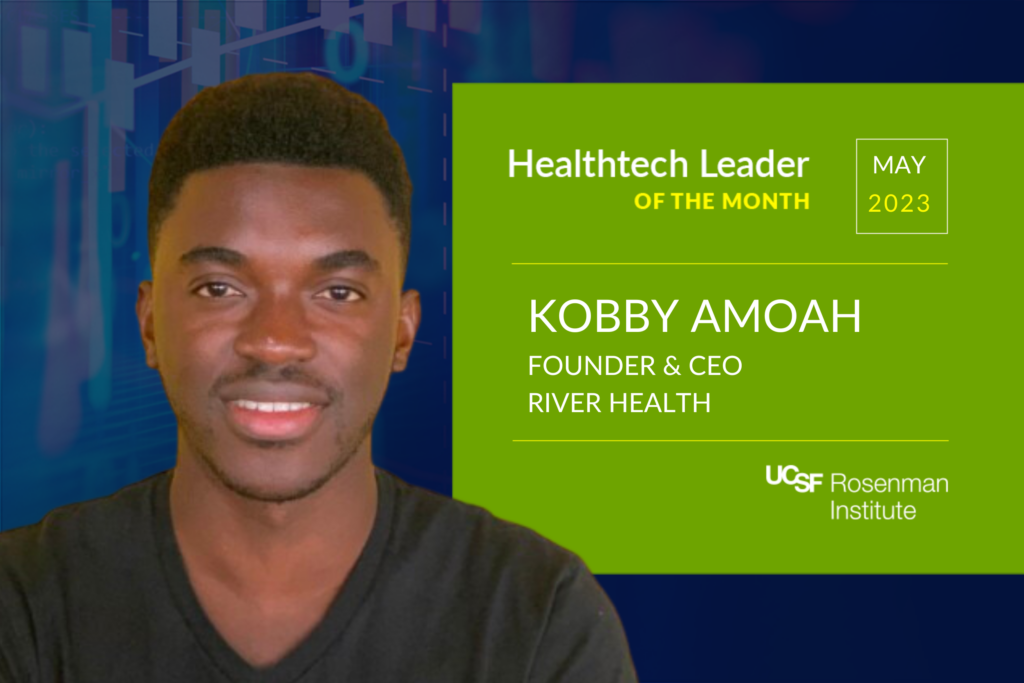For the May installment of the Healthtech Leader of the Month series, we spoke to Kobby Amoah, CEO of River Health. Kobby joined the UCSF Rosenman community as a 2021 ADAPT finalist and took the Founders Pledge.
River Health has developed a subscription service to provide comprehensive primary and behavioral care through a “virtual-first” health offering for just $35 a month.
A New Take on Healthcare
Prior to leading River Health, Kobby was a senior consultant at Merrill Lynch, a company that had an HR department that handpicked his health benefits. However, before Merill Lynch, Kobby’s benefits were left for him to figure out. “Trying to understand what a deductible is, what a co-pay is, what co-insurance is, what out-of-pocket maximums are is a complicated process,” Kobby explained. Over time, he realized the complexity of American healthcare is “not by accident, but by design.”
Still in finance, Kobby began trying to understand who the key players are in healthcare and how the system operates overall. “Understanding this becomes essential when you’re trying to build a product that people will actually use and are willing to pay for.” However, as he reflects on the beginning of River Health, Kobby affirms that, in some sense, “it’s good to be naive. If you know too much, you probably won’t start a company,” he jokes.
River Health was born in 2020 and offers unlimited virtual primary through a network of 25,000 clinics, with services such as free office visits, lab testing, and prescriptions. Kobby felt it was important to hire all of River Health’s primary care providers in-house. “Our providers wake up in the morning and sign into their River Health portal; they are not seeing in-person patients as well. This helps ensure users aren’t treated as second-class patients.” Patients also will see the same provider every visit: “Whether you’re sick or need a prescription refill, you will always see the same PCP,” says Kobby. River Health also offers wellness perks included in the membership, such as a Calm subscription and yoga passes, as well as professional virtual therapy from board-certified therapists. “As we started rolling out the product, we quickly realized that there’s a strong demand for mental health care services— treatment for anxiety, depression, and mood disorders, among others. We wanted to be able to support that as well,” says Kobby.
One of the biggest groups this platform serves is variable employees that traditionally do not have access to a simple way to receive comprehensive yet affordable health benefits. “That’s part-time employees, 1099 contractors, hourly employees, and seasonal workers, with the four biggest industries being food and beverage, retail, logistics, and healthcare,” Kobby specifies. “I think we have the most comprehensive and affordable solution on the market right now. Hands down,” Kobby concludes.
Leader to Leader: 3 Lessons Learned
1. Hire the Right People and Trust in Them
“As a first-time CEO, it is likely you will want to have your hands in everything and know everything that is going on. But the important thing is to hire competent people and trust them to do the job,” Kobby says.“I tell my team that I trust them to make decisions.”
2. Standardized & Defined Communication Channels
Kobby believes the job of a CEO is to be an information highway. “I try to give information to the right people rather than making decisions all the time” he says.
3. Make Sure Everyone is on the Same Page
“As a team, we make sure we stay true to our bottom-line metrics — constantly asking ourselves what really matters on any given day,” Kobby adds. Whether it be the number of patients served, revenue, or enrollment, Kobby makes sure his team is on the same page.
Looking Ahead:
In the upcoming months, Kobby expressed that he and his team are focused on building up River Health with its existing plans on the market right now. However, Kobby also added they are looking into coverage for specialty care, such as accidents. “We spend a lot of time thinking about the population we serve and what services they actually need. That’s what the future looks like for us,” says Kobby.
Join our Vibrant Community!
You’re not alone in your mission to bring better health technology to patients and medical professionals. Now more than ever, connecting with a global community of entrepreneurs is an invaluable step towards realizing your goals within the health technology world
Receive invitations to free and paid virtual events with healthtech entrepreneurs, payers, and service providers when you subscribe to our newsletter.
